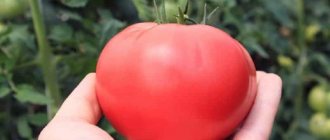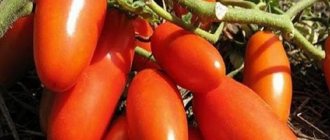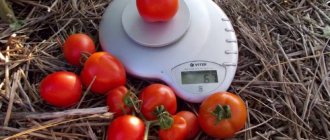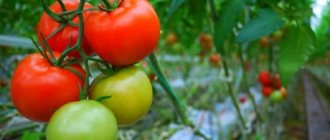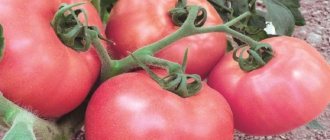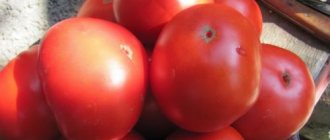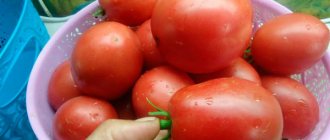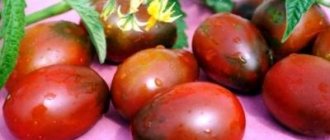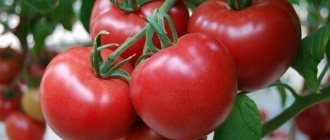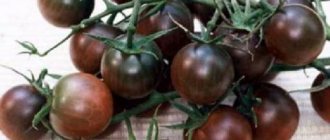Gardening season is approaching again. It's time to choose the best varieties. Yield tomato Thick cheeks will come in very handy for those who have low greenhouses. Compact tomatoes are extremely hardy and easy to grow.
| Height | Landing location | Ripening time | Fruit color | Fruit size | Origin | Fruit shape |
| short | Greenhouse, Open ground | Mid-early | Reds | Average | Variety | Flat-round |
Description of the variety
The tomato variety Thick Cheeks is declared as a medium-sized shrub, but in practice, under favorable conditions, it grows up to 2 m. Its fruits are red, large and fleshy. The shape is rounded-flattened and slightly ribbed. The weight of one tomato can reach 0.2-0.6 kg, and the yield from one bush can reach up to 6 kg. The taste is distinctly tomato, rich, sweetish, with a slight sourness.
The fruits of Thick Cheeks are perfect for pickling, canning and fresh cooking.
Being mid-season, the Thick Cheeks variety begins to bear fruit 3.5-4 months after emergence. The varietal feature is a long “swaying” in the first weeks, then the bush quickly gains strength and creates a good load - 5-8 tiers of fruit clusters.
Reviews about the variety from those who planted
The tomato variety “Thick Cheeks” will be a real find for every gardener. It is undemanding in care and also quite productive. In addition, tomatoes have excellent taste characteristics. Gardeners respond only positively to the “Fat Cheeks” variety.
“Thick cheeks” is undemanding to the type of soil, has good yield and resistance to diseases.
A tomato will certainly decorate your garden plot and guarantee a harvest with minimal effort.
Landing region
Since Thick Cheeks is a mid-season variety, ideal conditions for its growth will be in warm southern regions, where the fruits will fully gain ripeness and sweetness. However, gardeners successfully cultivate Shchechki in central Russia, in the central and southern Urals, and in western Siberia.
In the northern regions there is not enough heat and light, so preference is given to early-ripening tomato varieties with a shorter growing season. In addition to Russia, Thick Cheeks are cultivated in Ukraine, Moldova, and Belarus.
Tomato Thick cheeks: reviews, photos
When choosing the best variety of tomatoes, a gardener should focus not only on the yield of individual varieties of nightshades, but also on the difficulty of caring for them. One of the best options for such varieties is the Thick Cheeks tomato.
Characteristics of tomato variety Thick Cheeks
This crop has many advantages in cultivation. From one small bush you can get up to 5 kg of delicious sweet tomatoes.
Description of the tomato bush
Thick cheek tomatoes are easy to grow not only in a greenhouse, but also outside. In addition, the compactness of the bushes (up to 70 cm in height) is combined with the power of the stems, which can support a weight of fruit up to 5 kg. You still can’t do without tying. All necessary supports are installed immediately after planting the seedlings in the ground.
The foliage of this bush is medium-sized, dense, dark green. For the fruit to fully ripen, it is important to obtain a sunny color, so dense foliage is often pruned, as are the stepsons. Such measures help normalize the distribution of energy by the root system. This way the bush will concentrate its energy on ripening the fruits.
Features of cultivation
Seedlings are susceptible to cold
Tomatoes are best grown from seeds, sown in early spring. The process of growing seedlings is simple:
- The seeds are planted in fertile soil. You can buy a ready-made substrate or make it yourself by mixing garden soil with humus.
- After sowing, the pots are covered with polyethylene and put in a warm place.
- When the shoots appear, the film is removed and the containers with the sprouts are placed in a sunny place.
- Picking is carried out with the appearance of the second leaf.
Seedlings are prepared for transplanting outside or into a greenhouse only after warming the ground to 18°C. Any cold snap can destroy young plants, so in the northern regions it is better to plant them in a greenhouse. The seating scheme is dense: per 1 sq. m dig up to 5 bushes.
Tomatoes bear fruit better in areas where zucchini and cauliflower were previously grown. These plants leave behind a large amount of microelements useful for tomatoes.
For better growth, tomatoes need root feeding.
Caring for seedlings also has its own characteristics. It is better to water with warm, settled water. The frequency is determined by the condition of the soil, which should be loosened regularly. It is also important to fertilize. In total, they are carried out no more than 3 times during the season. It is best to use complex mineral formulations.
Diseases and pests
According to the description, the variety has disease-resistant immunity. He is not afraid of fusarium and verticellosis. If tomatoes are grown in a greenhouse, regular ventilation and moderate watering are important. Excess moisture and excessive soil moisture can cause blossom end and root rot.
The plant also needs preventative treatment. It is best to spray with specialized preparations. You can also use copper-containing compounds.
Tomato Thick cheeks. AelitaLarge-fruited tomatoes ✅ Choosing the best varieties of tomatoesTomato variety FAT JACK
Ripening time and yield
The entire period, from planting seeds to fruiting, is 110-120 days. The first tomatoes ripen by the end of July, but their harvest continues until the end of September. Then the last fruits are removed from the bush and left to ripen at 16-18°C.
On average, one bush growing in an open garden bed produces a harvest of 4-5 kg. In greenhouses, where conditions are ideal, you can harvest up to 6-7 kg. The largest fruits are formed at the beginning of fruiting.
Features of cultivation and storage
Grown through seedlings. The grown bushes are planted in the greenhouse or in open areas.
How to prepare seeds for planting:
- Treat for 15 minutes in 1% potassium permanganate.
- Keep overnight in a 0.5% soda solution.
- Immerse in 1% Fitosporin for 20 minutes.
It is preferable to use ready-made soil substrate. The soil from the park or garden is disinfected in any convenient way:
- bake in the oven for 15 minutes;
- irrigate with manganese solution;
- pour boiling water over it.
The harvest is harvested from mid-July to the end of September. The browned fruits ripen well. Storage is possible until mid-December.
Growing seedlings
Thick Cheeks are planted with seeds for seedlings in early March (seeds from Gavrish - in the second half of March). In the south of the country, sowing can begin by the end of February. Thus, the period between sowing and planting seedlings in the ground or greenhouse should be 55-60 days.
Growing seedlings requires good lighting, high humidity and a temperature of 16-25°C. The ideal place for this in the house would be the window sill. It is best if the seedlings are located on southern windows.
Preparatory work
Store-bought Fat Cheek seeds do not require preparation for planting, as they have been processed in production laboratories. It’s another matter if the seed was collected independently from the previous harvest. Then you need to disinfect it in order to eliminate possible pathogens. To do this, the seeds are soaked:
- in a 1% solution of potassium permanganate for 15 minutes;
- in a 0.5% soda solution for a day;
- in the preparation Fitosporin for 15-20 minutes.
It is better to purchase ready-made soil for planting seedlings, like the “Magic Bed.” But if the soil is brought from the garden, it can be:
- bake in the oven;
- pour boiling water over;
- treat with a strong solution of potassium permanganate.
The soil needs to be prepared 10 days before planting seeds or seedlings. During this time, the soil will rest and beneficial soil bacteria will begin to multiply in it.
Sowing seeds
You can plant seeds directly into the soil, for which any shallow container is suitable - boxes, peat cups, yogurt jars. Prepared moistened soil is poured into the container, seeds are placed on it and sprinkled with the same soil on top. The distance between the seeds should be 1-2 cm. The container is covered with film to create a greenhouse effect and placed in a warm place where the temperature reaches 30°C.
The humidity in the container should be at 80-90%, so when it dries, you need to moisten the soil with a spray bottle. If the film becomes waterlogged, open it a little and allow the contents of the container to dry. When fungus forms, the contaminated soil is carefully removed, and the remaining soil is treated with a solution of Fitosporin. Shoots appear in 3-14 days.
Picking and care
If the tomatoes were planted in one container, they will have to be picked. This is done after the first two true leaves appear on the seedlings. Later it is impossible, as it will be more difficult for the plants to take root. A couple of days before the procedure, the tomatoes are watered so that on the day of the dive the root system is not injured.
Further care of seedlings consists of maintaining external conditions. Daylight hours should be 16 hours a day, soil moisture should be 40-50%.
Do not allow excessive moisture or drying out. If it is a warm, windless day outside, the plantings can be exposed to the sun for a short time.
How to grow properly
Seed sowing for seedlings is recommended, carried out in the first weeks of spring:
- Seeds are planted in fertile soil. The substrate can be purchased ready-made at the store or made yourself by mixing garden soil and humus.
- Containers with sown seeds should be covered with plastic wrap and stored in a warm place. Remove the film daily for ventilation, moisten the soil as it dries.
- When the shoots appear, remove the film and place the pots with planting material in a well-lit place.
- Harden off the seedlings a week before transplanting to an open bed or greenhouse. The soil temperature for planting must be at least 20°C.
Growing and care
Young shoots can die even with a slight drop in air temperature, so in the northern part of the country it is preferable to plant planting material in a greenhouse. An area of 1 m2 can accommodate 5 bush plantings.
Note! The yield will be higher if zucchini or cauliflower grew in front of the tomatoes.
This is due to the large amount of useful substances in the soil that remain after they are grown.
To irrigate Thick Cheeks tomatoes, warm, settled water is used. The soil must be constantly loosened. Fertilize the crop twice per season with complex mineral compounds. As it grows, you need to do pinching so that the bush is formed correctly and does not branch.
Soil preparation
Thick Cheeks is a heat-loving plant, which means the area for it should be well heated and lit. Ideally, onions, cabbage or zucchini grew on it last season. Potatoes, eggplants, physalis and peppers will be bad predecessors. Wind protection is an important factor. In hilly areas, tomatoes are planted on southern slopes.
During the growth process, tomatoes actively consume potassium, nitrogen and phosphorus. Therefore, during autumn digging, you need to add these fertilizers to the soil, but in small quantities and in combination with organic matter - manure or compost. Fertilizers are scattered over the area and then dug up to a depth of a shovel. With the arrival of spring, the area is loosened a little, weeds are removed and the soil is leveled with a rake.
Reviews from gardeners
- Vladimir S., 58 years old: For the first time I planted the Thick Cheeks category in my garden, and did not regret it. The tomatoes are not large and even, the copra is juicy, and the taste is simply excellent. The care required was the same as for other varieties. Tomatoes are good to eat fresh; they make excellent preparations. Smaller fruits can be pickled with all their giblets. The color of the fruit is red, the skin is strong. Tomatoes can be kept raw for a long time without losing their flavor.
- Zinaida S., 55 years old: My neighbor in the country advised me to plant this variety of tomato. The last time I planted Thick Cheeks was last year and I was pleased. Pomona gifts are all smooth and dense. Great for marinating. Almost all of my family ate the fruits fresh, but some were used for processing. The taste of the fruit is sweetish, the flesh is tender. Now I will grow this variety every year.
- Olga, 48 years old: I really liked the Fat Cheeks variety. The bushes are not tall, they were grown in a greenhouse. (as stated in the instructions, I tore off the lower leaves and stepsons, tied them to wooden supports. The fruits all turned out smooth and bright red. Excellent for harvesting. Don’t forget about fertilizers. Over the summer, I fed the bushes with organic matter and minerals 3 times. Isn’t that all If you follow the rules, you can reap an excellent harvest. I was pleased with the result.
READ MORE: Shade-loving shrubs detailed description
Planting and watering
Planting work in the garden begins in the second half of May. When the site is ready, beds are made on it in the direction of the movement of the luminary. The distance between them is about 60 cm, between the holes - at least 50 cm. For ease of watering, the bed is made in the form of a groove, along which the holes are located in a checkerboard pattern. Then the water flows along the groove, feeding the roots of the plants without eroding them.
Before planting the seedlings, put a little wood ash, onion peels, chopped banana peels, and a yeast mixture of your choice into the hole. All this is a natural source of potassium, necessary for the normal growth of tomatoes.
Nitrogen fertilizers are not fed during this period.
Thick cheeks need to be watered in the evening, and generously, but not more than twice a week. For the first 10 days after transplanting seedlings, watering is not required, but then the following norms are observed:
- during the flowering period - up to 35 l. per 1 m2;
- during fruit setting - up to 50 liters. per 1 m2;
- during fruit growth and before they begin to ripen - up to 80 liters. per 1 m2.
Lack of moisture leads to the formation of a small number of ovaries and the formation of small fruits.
Characteristics of the tomato Fatty
This is a mid-early, determinate variety. It is recommended to grow it in greenhouses, greenhouses, and film-type shelters. In open ground, the Tolstushka variety is grown in the south of Russia.
The bush is not tall, the length of the stem does not exceed 80 cm, but it needs a garter, since full-sized fruits can damage the plant during the ripening period.
This is a natural variety, not a hybrid, its seeds are suitable for collection and further germination.
Seedlings of the Tolstushka variety are recommended to be rooted in areas where zucchini, parsley, and cauliflower were previously grown.
The fruits of the variety retain good presentation for a long time and are suitable for transportation. Thanks to the dense peel, they do not crack. If the fruits are collected at the stage of technical maturity, they can be stored for a long time in a cool room, and spontaneous ripening occurs.
Since 2011, the Tolstushka tomato has been included in the State Register of the Russian Federation as a variety recommended for cultivation in spring film greenhouses.
Tomato yield Fatty and fruiting
The ripening of Tolstushka tomatoes begins in the second half of July. Farmers harvest up to 7 kg of tomatoes from one bush. The weight of the first fruits reaches 250 g, the second harvest is more modest: the weight of each tomato does not exceed 190 g.
It is recommended to grow the Tolstushka tomato under film and only in the southern regions - in open ground
Regular watering and fertilizing have a good effect on crop productivity. In warm climates with stable temperature conditions, the Tolstushka variety bears fruit best.
Fruit ripening is uniform, which greatly simplifies harvesting. It is recommended to remove tomatoes from the bush once a week. The fruits can be harvested at technical maturity; they turn red quickly, are stored well, retain a unique taste, and the plant has the ability to quickly form new ovaries without becoming depleted.
Area of application of fruits
Tomatoes of the Tolstushka variety have a universal purpose: they are suitable for processing and fresh consumption. The large size of the fruit does not allow it to be used for whole fruit canning. Tomato juice, paste, lecho, and various sauces are prepared from tomatoes. The taste of tomatoes of the Tolstushka variety is well revealed in summer salads with herbs.
Resistance to diseases and pests
The tomato is resistant to diseases, especially fusarium and verticillium, but can suffer from blossom end rot. Bushes must be regularly inspected and quickly responded to the appearance of the first signs of disease. Insects rarely attack the Tolstushka variety.
Harvesting
Thick Cheeks tomatoes are harvested in the second half of summer - early autumn. Mass ripening of the fruits is observed by mid-August, and the last harvest is harvested by the end of September during the harvesting of the tops. Then the brown tomatoes are carefully placed in a box for ripening.
Some gardeners act differently: they leave the last fruits on the tops, which they carefully remove from the ground and hang at a height in a cool place. Thus, tomatoes ripen thanks to the nutrients that remain in the above-ground part of the plant, and are perfectly stored until December.
Positive traits
The variety has a fairly large number of positive qualities. Description of main properties:
- High yield of tomatoes, which is characterized by unique stability from year to year.
- This is a very picky variety that does not require complex care.
- Due to the high-quality work of breeders, the Thick Cheeks tomato variety is resistant to 90% of known diseases.
- Due to their strong skin, tomatoes do not wrinkle. They can be stored for a long time and are very convenient to transport.
- The rich sweetish taste and attractive appearance make the fruit a very popular product on the market.
- Weather resistant. The plant tolerates both cold and high temperatures equally well.
Pros and cons of the variety
Thick cheeks as a variety have many advantages:
- excellent and stable yield;
- marketable appearance of the fruit;
- good transportability;
- long shelf life;
- unpretentiousness to external conditions;
- ease of care;
- resistance to diseases.
The disadvantages of the variety include the pronounced sour taste of the fruit with insufficient heat and light, although in general the characteristics of Thick Cheeks are rated quite highly. It’s worth planting them on your site once to see for yourself.
Diseases and pests
The tomato variety “Thick Cheeks” is highly resistant to diseases typical of tomatoes; it is not afraid of fusarium and verticillium. When growing in greenhouse conditions, it is important to regularly ventilate the room and water moderately. High humidity and overly moist soil can cause blossom end and root rot. You should also remember about preventive measures. It is advisable to spray the plantings with specialized preparations and treat them with copper-containing compounds.
